 |
|||

|  |

|
|

September 17, 2010 |
||
| Strong focus on quality, tradition set apart Old Europe Cheese’s products | ||
By Kate Sander BENTON HARBOR, Mich. — Good wine can’t come from sour grapes and neither can good cheese come from milk that isn’t of the highest quality. That’s why Old Europe Cheese Inc., Benton Harbor, Mich., puts so much emphasis on milk quality as well as production quality, says Michael Balane, national sales manager, Old Europe Cheese. “If you want to make a great cheese, you have to start out with great milk,” he says. Old Europe Cheese, which manufactures Brie and Camembert, its signature products, as well as Edam, Gouda and other assorted semi-soft cheese types, sources its Grade A, rbST-free milk from Michigan Milk Producers Association (MMPA). Located not far from the eastern shores of Lake Michigan, Old Europe Cheese’s plant then combines state-of-the-art technology with time-tested traditional production techniques to make its cheeses. Old Europe Cheese’s use of its own specialized cultures is another way it is set apart from other companies, Balane says. Instead of using freeze-dried cultures, the company operates its own incubation room and makes its own cultures. This gives the cheese its own distinctive flavor and makes the most of the local milk’s terroir. The company’s staff also brings years of experience: General Manager Francois Capt has Capt is quick to note, too, that he is not the only one who keeps the plant — which produces about 7 million pounds of cheese annually — in top working order. “All of the managers of the plant take responsibility and work hard,” he says, noting there is a great deal of longevity among the company’s staff. Old Europe Cheese always has focused on quality, Capt says, and in recent years even more so as customers’ traceability and inspection needs have increased. “We are always improving production systems, and I think this year we are doing even more than before,” Capt says. “Food safety and quality are very important, and our goal is to ensure that,” he adds.
The company’s efforts to provide top-notch products are paying off in competitions around the nation. At the recent World Dairy Expo contest sponsored by the Wisconsin Dairy Products Association, the company’s Triple Crème Brie won first in the open class and its Camembert Fermier placed second. The company’s goat’s milk Gouda also placed second in the goat’s milk cheese class. Earlier this year in the World Championship Cheese Contest sponsored by the Wisconsin Cheese Makers Association, the company’s Brie and goat’s milk Gouda also each took third place in their respective classes. The company’s Brie was the highest-placing domestic Brie in the competition. Balane notes that Old Europe’s cheeses have done consistently well in competitions and, because the company’s production is large enough, the company can meet the needs of customers who are seeking out award-winning cheeses. About half of the company’s cheese goes into foodservice and the other half into retail, though the retail business is steadily growing. The cheeses, marketed primarily under the Reny Picot brand, can be found at many major retail chains including Ahold, Food City, Price Chopper, Safeway and various SuperValu banners. Old Europe Cheese always is looking to innovate, and one of the recent upgrades the company made was to introduce new packaging to give its semi-soft cheeses — including Reny Picot Gouda, Edam, Fontina and Mantoro — a fresh appearance and enhance brand continuity. “We wanted to establish a unified presence,” Balane says. “Before, each of our products The new labels feature the same Reny Picot logo and cow that are familiar to consumers, but add a new field scene with butterflies and a daisy. Softer colors are used to specify each cheese variety. The new look is designed to enhance and complement the fresh wholesome goodness of Reny Picot cheese, Balane says. In the past two years, the company has introduced new products including its St. Rocco Triple Crème Brie available in 8-ounce exact weight wheels, 8-ounce saran wrapped wedges and 3-kilo wheels. The cheese is 70 percent butterfat and features “velvety nuances and essence of mushroom,” the company says. Old Europe Cheese also has introduced an 8-ounce and 16-ounce exact weight rectangular Brie for slicing. The cheese is hand wrapped in gold foil. In addition, the company has introduced a Light Brie. While the Light Brie — like most companies’ light cheeses — hasn’t acquired a large following in its first year of production, Balane calls the product “full flavored” and says Old Europe focused on ensuring it had good flavor before it was ever brought to market. It serves an important purpose for consumers who are looking to eat more healthfully but still want to indulge in flavorful cheese. Last year the company also developed its United Mehardrin (UM) Kosher Brie for industrial and retail markets. In an effort to cut labor and costs for its customers, Old Europe Cheese also is offering a cut-and-wrap program for Brie and semi-soft cheeses. The program includes precut random and exact weight cheeses fully labeled for reduced labor at the deli counter. “We rarely say ‘no’” to a customer’s needs, Capt says. “We do everything we can to satisfy demand. We innovate a lot, and reinvest.”
Old Europe Cheese historically has been a somewhat quiet company on the marketing front, growing by word of mouth and its quality reputation, Balane says. The plan seems to have worked. The company does particularly well on the East and West Coasts, but it also is beginning to make inroads in the Midwest, something the company will be concentrating more on over the next few years, Balane says. “Our goal is to increase sales 5-10 percent every year; we can’t go too fast,” Capt says. “We want to continue to do what we do, and get even better.” CMN
|
||
| CMN article search |
|
|
© 2025 Cheese Market News • Quarne Publishing, LLC • Legal Information • Online Privacy Policy • Terms and Conditions
Cheese Market News • Business/Advertising Office: P.O. Box 628254 • Middleton, WI 53562 • 608/831-6002
Cheese Market News • Editorial Office: 5315 Wall Street, Suite 100 • Madison, WI 53718 • 608/288-9090
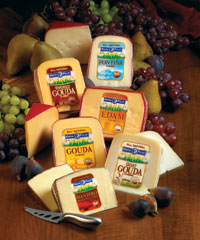
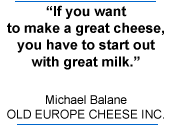 been with the plant since Old Europe Cheese opened in Benton Harbor in 1988, and he has been general manager since 1990. Originally from France, he is a fourth-generation cheesemaker.
been with the plant since Old Europe Cheese opened in Benton Harbor in 1988, and he has been general manager since 1990. Originally from France, he is a fourth-generation cheesemaker.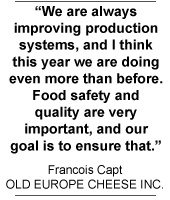 As part of this, the company has begun implementing the Safe Quality Food (SQF) program and expects to have its certification finalized by the early part of next year.
As part of this, the company has begun implementing the Safe Quality Food (SQF) program and expects to have its certification finalized by the early part of next year.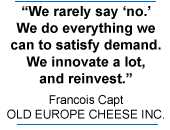 had its own individual look.”
had its own individual look.”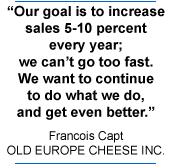 Old Europe Cheese benefits from being both a medium-sized manufacturer as well as being a subsidiary of a large international company. In 1987, Madrid, Spain-based Industrias Lacteas Asturianas (also known as I.L.A.S.), bought a former milk processing plant from MMPA to start Old Europe Cheese. I.L.A.S., which marked its 50th year in business this year, invested in the Michigan facility so it could provide U.S. consumers with cheeses that had a longer shelf life than cheeses imported from Europe. The varieties produced by Old Europe Cheese also have a consistency and flavor profile that’s generally more palatable to U.S. consumers, Capt says, noting, for example, that the company’s Brie is a bit drier than the Brie made in France.
Old Europe Cheese benefits from being both a medium-sized manufacturer as well as being a subsidiary of a large international company. In 1987, Madrid, Spain-based Industrias Lacteas Asturianas (also known as I.L.A.S.), bought a former milk processing plant from MMPA to start Old Europe Cheese. I.L.A.S., which marked its 50th year in business this year, invested in the Michigan facility so it could provide U.S. consumers with cheeses that had a longer shelf life than cheeses imported from Europe. The varieties produced by Old Europe Cheese also have a consistency and flavor profile that’s generally more palatable to U.S. consumers, Capt says, noting, for example, that the company’s Brie is a bit drier than the Brie made in France.